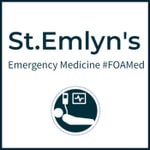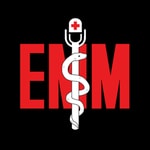The St.Emlyn’s Podcast – Details, episodes & analysis
Podcast details
Technical and general information from the podcast's RSS feed.

The St.Emlyn’s Podcast
St Emlyn’s Blog and Podcast
Frequency: 1 episode/15d. Total Eps: 273

Recent rankings
Latest chart positions across Apple Podcasts and Spotify rankings.
Apple Podcasts
🇬🇧 Great Britain - medicine
25/07/2025#85🇬🇧 Great Britain - medicine
22/07/2025#91🇬🇧 Great Britain - medicine
18/07/2025#88🇬🇧 Great Britain - medicine
17/07/2025#56🇬🇧 Great Britain - medicine
16/07/2025#33🇬🇧 Great Britain - medicine
15/07/2025#42🇬🇧 Great Britain - medicine
14/07/2025#55🇬🇧 Great Britain - medicine
13/07/2025#38🇬🇧 Great Britain - medicine
12/07/2025#26🇬🇧 Great Britain - medicine
11/07/2025#82
Spotify
No recent rankings available
Shared links between episodes and podcasts
Links found in episode descriptions and other podcasts that share them.
See all- https://twitter.com/Reynard_EM
6 shares
- https://twitter.com/stemlyns
2 shares
RSS feed quality and score
Technical evaluation of the podcast's RSS feed quality and structure.
See allScore global : 58%
Publication history
Monthly episode publishing history over the past years.
Ep 242 - Prehospital Neuroprotection with Ed Langford at PREMIER 2024
Season 11 · Episode 13
mercredi 21 août 2024 • Duration 11:09
In this episode, we delve into the critical role of neuroprotection in pre-hospital care, particularly in pediatric head injuries. Through a real-life case study of a 13-year-old boy who suffered a traumatic brain injury after being hit by a car, we explore the steps taken by paramedics and critical care teams to stabilize him and prevent further neurological damage. From airway management to advanced interventions, this episode highlights the challenges of pre-hospital neuroprotection and the incredible teamwork that led to the patient’s remarkable recovery.
There is more detail on the full blogpost here.
This podcast was recorded live at the Hope Church in Winchester as part of the PREMIER conference. We are grateful to the organizing team for hosting us and allowing us to use the audio. The PIER and PREMIER websites are full of amazing resources for anyone working in Paediatric Emergency Medicine, and we highly recommend them.
The SpeakerEd is a Speciality Trainee in Emergency Medicine in Wessex and a trainee Critical Care Practitioner with Dorset and Somerset Air Ambulance. Ed is also the co-founder and Managing Director of Enhanced Care Services, a Southampton-based company delivering enhanced and critical care to the event medical sector, providing frontline ambulance services across Hampshire and clinical education at all levels, employing over 200 clinicians. Ed holds the Diploma in Immediate Medical Care (RCSEd) and, having promised to not take on any more work, is currently undertaking a Masters in Resuscitation, Pre-hospital and Emergency Medicine at QMUL.
Enhanced Care ServicesEnhanced Care Services' mission is to provide and influence excellent patient care, irrespective of injury, illness or location, through the delivery of high-quality clinical operations and education. Founded in 2015, ECS now provide frontline ambulance operations across the South, delivers extensive medical cover to some of the most prestigious events across the UK and provides education from its bespoke education centre in Southampton and beyond.
Ep 241 - Paediatric Palliative Care with Tim Warlow at PREMIER 2024
Season 11 · Episode 12
mercredi 14 août 2024 • Duration 10:51
In this episode, Dr Tim Warlow, a consultant in Paediatric Palliative Care, explores the complexities of caring for children with life-limiting conditions in the emergency department (ED). The discussion highlights the increasing prevalence of paediatric life-limiting conditions and the growing medical complexity of these cases, which pose significant challenges for ED staff.
The episode begins by clarifying what paediatric palliative care truly involves. Contrary to common misconceptions, palliative care is not about withdrawing care but rather enhancing the quality of life for children from the point of diagnosis, whether the condition is present from birth or develops as the child deteriorates. This proactive approach often involves increasing the level of care and support as the child’s needs evolve.
As the number of children with life-limiting conditions continues to rise, EDs are encountering more medically complex cases, including children who are technology-dependent and require high levels of care at home. These challenges are compounded by the evolving expectations of parents, who are often better informed and more involved in their child's care decisions. Post-COVID, community services have struggled to recover, particularly in nursing support, making the role of the ED even more critical.
The episode provides practical tips for ED professionals to better manage these cases. Key strategies include:
-
Recognising Life-Limiting Conditions: With over 400 recognized life-limiting conditions and many more undiagnosed, it’s crucial to assess whether a child might have palliative care needs.
-
Listening to Families: Families often have an intimate understanding of their child’s unique medical baseline. Listening deeply to their insights, even when they seem unusual, is essential for providing appropriate care.
-
Building Rapid Rapport: Quickly establishing a connection with the family is vital, as these children can deteriorate rapidly. Acknowledging the child’s presence, summarizing the situation, and validating the family’s experience can help build trust.
-
Understanding the Child Beyond Their Illness: Families worry that healthcare professionals only see their child when they are unwell. Taking the time to learn about the child’s life outside of the hospital can lead to better care decisions.
-
Reading the Advanced Care Plan: If available, review the child’s advanced care plan before discussing the case with the family. This ensures that the family doesn’t have to recount their entire journey and that care decisions are based on the most current information.
The episode also addresses the importance of being aware of unconscious prejudice. Healthcare professionals must ensure that decisions are based on the child’s specific needs rather than assumptions about their quality of life due to their disability.
In conclusion, the episode emphasizes that while caring for children with life-limiting conditions in the ED is challenging, it is also deeply rewarding. The key to providing excellent care lies not just in medical interventions but in being present, listening, and supporting the family through difficult times. Whether things go as planned or not, your presence and compassion are what families remember most.
This episode is a must-listen for anyone involved in pediatric care, offering valuable insights into the critical role of the ED in supporting children with life-limiting conditions and their families. There is more detail on the blogpost here.
Ep 232 - April 2024 Monthly Round Up - Bougies, cardiac arrest, trauma, sepsis, race and medicine and choosing with intention
Season 11 · Episode 5
mercredi 5 juin 2024 • Duration 30:11
Welcome to St Emlyn's Monthly Round Up Podcast, your go-to source for the latest insights, developments, and discussions in emergency medicine and critical care. Each month, Iain and Simon bring you in-depth analysis, evidence-based practices, and practical advice to enhance your clinical practice and professional development.
You can find an in-depth set of shownotes on St Emlyn's. Please do also like and subscribe, wherever you get your podcasts.
This month's content includes...
Introduction 00:00 - 00:34 Do Bougies increase first pass success? 00:34 - 04:28 Cardiac arrest management - dual sequence defibrillation, personalised care and drones for AEDS. 04:28 -10:50 Trauma - Cardiac tamponade vs exsanguination 10:50 - 13:35 Sepsis - effect of the microcirculation 13:35 - 15:23 A history of race and medicine 16:54 - 18:36 Differential attainment 18:37 - 19:27 What can we do about addressing EDI issues? 19:28 - 22:20 Choosing with intention 20:21 - 26:55 The ARC-H Principle 26:56 - 28:32 Closing thoughts 28:33 - 30:10 Recommended ConferencesPremier Conference - 11th-12th June 2024, Winchester
Ep 142 - Psychological performance in the Resus Room with Ashley Liebig
Season 6 · Episode 15
mardi 23 juillet 2019 • Duration 20:52
This talk focuses on how we can optimise our psychological performance in critical care situations, the type of situations that Simon describes as Time Critical, Information light. The Audio is available below, or watch the full presentation above.
Don't forget to watch the video on the St Emlyn's site http://www.stemlynsblog.org
vb
S
Ep 141 - June 2019 Round Up
Season 6 · Episode 14
dimanche 14 juillet 2019 • Duration 27:36
Emergency medicine is a field full of paradoxes, where the definition of a "good day" can differ starkly between healthcare professionals and their patients. This contradiction was a central theme in the discussions from June, which included reflections on the Don’t Forget the Bubbles (DFTB) conference, as well as key topics like the emotional toll of emergency medicine, the evolving nature of adolescent healthcare, and the importance of continuous learning.
Don’t Forget the Bubbles Conference: A Valuable Resource for Pediatric Emergency MedicineThe DFTB conference, held in London this year, has quickly become an essential event for those involved in pediatric emergency medicine. With a focus on both pediatric and adolescent healthcare, the conference offers invaluable insights and practical advice that can benefit even those who primarily work in adult emergency medicine.
One of the standout topics from the conference was the Paradox of a Good Day in Emergency Medicine. This paradox arises from the nature of emergency medicine, where a "good day" for a clinician—filled with successful procedures and exciting cases—often coincides with what is likely the worst day of a patient’s life. This duality highlights the emotional and ethical complexities that emergency physicians must navigate. As practitioners advance in their careers, they often shift from focusing on the technical aspects of their work to becoming more aware of the profound impact these situations have on patients and their families.
The Emotional and Psychological Impact of Emergency MedicineThe emotional burden of emergency medicine was another significant theme at the DFTB conference, especially in sessions led by Kim Holt and Neil Spenceley. Holt, who has been involved in whistleblowing in the high-profile Baby P case, shared her experiences of dealing with criticism and professional challenges. Her story serves as a reminder of the resilience required to navigate the ethical and emotional complexities of healthcare.
Spenceley’s session on doctors in distress emphasized the importance of creating supportive systems within healthcare departments. He argued that instead of focusing on making individuals more resilient, we should design systems that inherently support healthcare professionals. This shift in perspective is crucial in addressing the high levels of burnout and stress among emergency medicine practitioners.
Laura Howard’s research on the psychological well-being of emergency physicians further explored this issue. Her qualitative study, which involved interviews with senior emergency physicians, revealed that the emotional impact of the job affects everyone, regardless of their experience level. Events like traumatic deaths, particularly those involving children or body disruptions, were identified as particularly distressing and had lasting effects on the practitioners involved. Howard’s work underscores the need for robust support systems to help clinicians manage the cumulative toll of their work.
Bridging the Gap in Adolescent MedicineThe DFTB conference also shed light on the often-overlooked area of adolescent healthcare. As healthcare providers, we tend to categorize patients as either adults or children, but adolescents require a tailored approach that addresses their unique needs. Russell Viner, a leader in pediatric healthcare, discussed how the concept of adolescence has evolved over time. In previous generations, adolescence was a brief period between puberty and adulthood, often marked by early milestones like starting a family. Today, however, adolescence is prolonged, with young people delaying traditional markers of adulthood due to social, educational, and economic factors.
This shift has significant implications for how we approach healthcare for adolescents. In our practice, we must ensure that we are not only addressing the physical health of teenagers but also their mental and emotional well-being. This includes creating healthcare environments that are welcoming and appropriate for adolescents and offering resources that cater to their specific health concerns.
Continuous Learning: Beyond ATLS and Traumatic Cardiac ArrestThe importance of continuous learning and staying current with the latest research and best practices was another key message from June. Alan Grayson’s talk on going beyond ATLS (Advanced Trauma Life Support) was particularly impactful. While ATLS has been a cornerstone of trauma care globally, Grayson challenged us to think critically about its limitations, especially in high-income countries where multi-disciplinary teams are the norm.
Grayson emphasized the need to focus on the basics—such as administering tranexamic acid, providing adequate analgesia, and ensuring timely administration of antibiotics—before diving into more advanced interventions like REBOA (Resuscitative Endovascular Balloon Occlusion of the Aorta). This back-to-basics approach serves as a crucial reminder that even in a high-tech medical environment, the fundamentals of care are what ultimately save lives.
Jason Smith’s session on traumatic cardiac arrest offered new insights into how we approach this challenging situation. Traditional management has focused on chest compressions, adrenaline, and fluid resuscitation, but emerging evidence suggests that in cases of traumatic cardiac arrest, these interventions may not be as beneficial as once thought. Instead, giving blood and stopping the bleeding were identified as more critical interventions. However, Smith cautioned that this approach should be reserved for hypovolemic cardiac arrest, highlighting the importance of understanding the underlying cause of the arrest before determining the treatment course.
The Reality of Intraosseous (IO) Blood SamplingA more technical but equally important topic discussed in June was the use of intraosseous (IO) blood sampling. For years, many clinicians have been taught that IO access can provide reliable blood samples for analysis. However, recent evidence suggests otherwise. A systematic review revealed that while it might be possible to obtain certain values like hemoglobin and sodium, the reliability of these results is questionable. Moreover, using IO samples for blood gas analysis or putting marrow through automatic analyzers can lead to equipment malfunction, a concern that has understandably caused anxiety among laboratory staff.
Given this evidence, it’s clear that we need to rethink our approach to IO blood sampling. While it might still have a place in certain situations, particularly for microbiological cultures, relying on IO samples for comprehensive blood analysis is not advisable. This is another example of how continuous learning and critical evaluation of existing practices are essential for improving patient care and ensuring the best possible outcomes.
Conclusion: Moving Forward with Insights from JuneAs we reflect on the lessons from June, it’s evident that emergency medicine is a constantly evolving field that demands both continuous learning and emotional resilience. Whether through attending conferences like Don’t Forget the Bubbles, staying updated on the latest research, or addressing the psychological impact of our work, it’s clear that adaptation and mutual support are key to thriving in this challenging yet rewarding profession.
At St Emlyn's, we are committed to fostering a culture of lifelong learning, open discussion, and mutual support. As we move into the second half of the year, let’s carry forward the insights we’ve gained, keep pushing the boundaries of our knowledge, and continue to support each other in the demanding yet rewarding field of emergency medicine. Take care, and keep up the incredible work you do.
Ep 140 - GI emergencies with Chris Gray at #stemlynsLIVE
Season 6 · Episode 13
jeudi 4 juillet 2019 • Duration 20:56
This is Chris's talk from #stemlynsLIVE on GI emergencies. Remember to check out the blog for the background, references and more.
Ep 139 - May 2019 Round Up
Season 6 · Episode 12
vendredi 21 juin 2019 • Duration 32:45
St. Emlyn's Podcast: Key Insights from May in Emergency Medicine
As we transition into the warmer months, it's an opportune time to reflect on recent discussions and developments within the field of emergency medicine, particularly those highlighted in the latest episode of the St. Emlyn's podcast. This episode covered a wide range of topics, from workplace safety to advancements in pediatric care and innovative approaches in patient management. Below is a comprehensive summary of the key points discussed.
Workplace Safety: A Pressing ConcernThe podcast began with a reflection on a recent violent incident at Newham Emergency Department (ED), which served as a stark reminder of the dangers healthcare professionals face daily. Emergency departments, by their very nature, are open and accessible, making them vulnerable to violent incidents. This recent attack has prompted a nationwide reassessment of safety measures, with many EDs enhancing their protocols to protect staff.
The conversation emphasized that violence in the workplace should never be normalized. It’s crucial that healthcare professionals feel safe and supported in their working environment. Leadership within departments plays a critical role in this, not only by implementing robust safety protocols but also by fostering a culture of solidarity and mutual support among staff. The incident at Newham underscores the need for constant vigilance and proactive measures to ensure the safety of everyone working in emergency medicine.
Leadership in Education: Simon Carley’s New RoleIn more positive news, Simon Carley’s recent appointment as the CPD (Continuing Professional Development) lead for the college was discussed. This role is a significant milestone, not just for Simon but also for the integration of modern educational approaches within formal medical education. Simon’s involvement with St. Emlyn's has long been focused on innovative, social media-driven education, and this new role offers an opportunity to bring these methods into a broader educational framework.
The appointment highlights the value of combining traditional education with the dynamic, accessible formats offered by the #FOAMed (Free Open Access Meducation) community. It’s a recognition that medical education can benefit from new perspectives and that the integration of these ideas can enhance the learning experiences for healthcare professionals.
Pediatric Status Epilepticus: Evaluating Second-Line AgentsThe discussion moved to a detailed analysis of pediatric status epilepticus, focusing on the findings from two key trials: the Eclipse trial and the ConSEPT trial. These studies compared the efficacy of levetiracetam (Keppra) and phenytoin as second-line agents for stopping seizures in children.
The trials found no significant difference between the two drugs in terms of their effectiveness, which has led to debate within the medical community about whether to switch from phenytoin to levetiracetam. While levetiracetam is perceived as easier to administer and safer, the lack of a clear superiority has left the decision somewhat open. However, the ease of use and safety profile of levetiracetam make it an appealing option, and some institutions are considering making the switch.
For clinicians, the takeaway is that while both drugs are viable options, the choice may ultimately come down to individual preferences and institutional protocols. The trials underscore the importance of continuous evaluation of treatment options, particularly in complex cases like pediatric seizures.
Understanding Clinical Trials: The Importance of Statistical LiteracySimon Carley also highlighted the importance of understanding the statistical nuances in clinical trials, particularly the difference between demonstrating a difference between treatments and establishing their equivalence. This distinction is crucial for accurately interpreting research findings and making informed clinical decisions.
The discussion emphasized that clinicians must be cautious in how they interpret trial results, particularly when it comes to determining whether treatments are genuinely equivalent or if the lack of a significant difference merely reflects the study’s design. This level of critical appraisal is essential for ensuring that new research is applied correctly in clinical practice.
Prolonged Field Care in the ED: Learning from Military MedicineAnother topic discussed was prolonged field care, a concept borrowed from military medicine that is becoming increasingly relevant in emergency departments due to overcrowding and delays. Rich Carden introduced the HITMAN mnemonic—Hygiene and Hydration, Infection, Tubes, Medication, Analgesia, and Nutrition—as a framework for managing patients who are stuck in the ED for extended periods.
The HITMAN approach ensures that patients' fundamental needs are met even when resources are stretched. This method helps prevent complications and improves patient outcomes, even in less-than-ideal conditions. The approach is particularly relevant in today’s healthcare environment, where EDs are often overwhelmed and patients may wait longer than usual for admission or transfer.
Atrial Fibrillation: Reassessing Cardioversion StrategiesAtrial fibrillation (AF) management was another key topic. A recent study in the New England Journal of Medicine compared immediate cardioversion with a wait-and-see approach in patients with new-onset AF. The study found that a wait-and-see approach was non-inferior to immediate cardioversion, with 69% of patients in the wait-and-see group spontaneously cardioverting within 48 hours.
This finding challenges the traditional approach of immediate cardioversion and suggests that in many cases, a more conservative approach may be just as effective. However, the decision should be made through shared decision-making with the patient, taking into account their preferences and the specific circumstances of their condition. This patient-centered approach ensures that treatment decisions are made collaboratively and with the patient’s best interests in mind.
Traumatic Cardiac Arrest: Reevaluating Chest CompressionsThe podcast also touched on the evolving management of traumatic cardiac arrest, particularly the role of chest compressions. Recent studies, including one involving porcine models, suggest that in cases of hypovolemic traumatic cardiac arrest, chest compressions may not be beneficial and could even be harmful. Instead, the focus should be on addressing the underlying cause, such as restoring circulating volume.
This shift in practice highlights the importance of understanding the specific etiology of cardiac arrest and tailoring resuscitation efforts accordingly. Communicating these changes to the entire resuscitation team is crucial, as there may be resistance to deviating from traditional protocols. Ensuring that everyone is on the same page and understands the rationale behind the approach is key to successful implementation.
Virtual Reality in Pain Management: An Emerging ToolVirtual reality (VR) is emerging as a promising tool in pain management, particularly in pediatric patients undergoing painful procedures. A recent study discussed in the podcast found that children who used VR experienced less distress during procedures compared to those who received standard care.
VR offers an innovative, accessible method for managing pain and anxiety, and its use is likely to expand in the coming years. The ability to create immersive environments that distract patients during procedures has the potential to improve patient experiences and outcomes, not just in children but potentially in adults as well.
The Power of Peer Review: Enhancing Clinical PracticeFinally, Simon Carley discussed the importance of peer review in clinical practice. Peer review is a valuable tool for continuous improvement, allowing clinicians to receive feedback from colleagues on their performance. While it can be challenging to create a culture where feedback is welcomed and constructive, the benefits are significant.
Peer review helps clinicians avoid complacency, stay up-to-date with best practices, and continually refine their skills. It’s a simple, cost-effective way to ensure that healthcare professionals are delivering the highest standard of care. Creating a supportive environment where feedback is seen as an opportunity for growth rather than criticism is essential for the success of peer review initiatives.
ConclusionThe discussions in this month’s St. Emlyn's podcast highlight the complexities and challenges of working in emergency medicine, from ensuring workplace safety to staying current with evolving practices. By engaging with new research, embracing innovative tools like virtual reality, and fostering a culture of continuous improvement through peer review, we can continue to advance the field and improve patient care. As always, the St. Emlyn's blog and podcast remain valuable resources for staying informed and connected with the latest developments in emergency medicine.
Ep 138 - Traumatic Cardiac Arrest with Prof Jason Smith RN
Season 6 · Episode 11
vendredi 7 juin 2019 • Duration 25:33
Traumatic cardiac arrest (TCA) is a critical and often fatal condition encountered in both military and civilian emergency medicine. Historically, the prognosis for patients with TCA has been poor, leading many to believe that resuscitation efforts are largely futile. However, recent developments, particularly those arising from military experience, are challenging this perspective. In this post, we explore insights shared by Dr. Jason Smith, a consultant in emergency medicine and a seasoned military doctor, about the evolving understanding of TCA, including the role of chest compressions and the application of military practices in civilian settings.
Traumatic Cardiac Arrest: Insights from Military ExperienceTCA is relatively rare in civilian settings, with major trauma centres like Plymouth seeing a case every one to two months. However, in military environments, where high-velocity injuries are more common, TCA occurs more frequently. Dr. Jason Smith’s experience in Afghanistan revealed that traumatic cardiac arrests happened as often as three to four times a week. This stark contrast has driven the development of specific management protocols in military settings, where hemorrhagic shock is the leading cause of TCA.
In these high-intensity environments, the focus is on immediate and aggressive interventions. These protocols, developed on the battlefield, have significantly improved outcomes and are now being adapted for civilian trauma centres, where they continue to challenge the longstanding belief that TCA is nearly always fatal.
From the Battlefield to the Emergency Room: Evolving TCA ManagementOver the past decade, the management of TCA has undergone significant evolution, largely influenced by military practices. Dr. Smith’s team in Afghanistan developed a "bundle of care" designed to rapidly and effectively address the key factors leading to TCA. This bundle includes:
- External Hemorrhage Control involves ensuring that tourniquets are properly applied and functioning, alongside other measures to control external bleeding.
- Oxygenation and Ventilation: Rapid intubation and ventilation to maintain oxygen delivery to vital organs.
- Bilateral Thoracostomies: Decompressing the chest on both sides to manage potential tension pneumothorax.
- Rapid Volume Replacement: Administer warm blood and blood products intravenously or intraosseously to quickly replace lost volume.
- Pelvic Binding: Applying a pelvic binder in cases of blunt trauma to reduce pelvic volume and control bleeding.
- Consideration of Thoracotomy: In specific cases, such as penetrating trauma to the chest, thoracotomy is considered as a life-saving intervention.
This structured approach, honed in military contexts, has led to outcomes that are significantly better than those reported in civilian literature at the time. These practices are now being adapted for civilian use, where they are helping to improve survival rates for TCA patients.
Challenging Old Assumptions: New Data on TCA SurvivalOne of the most significant shifts in the perception of TCA has come from recent data showing that survival rates are not as dismal as previously thought. In military populations from Iraq and Afghanistan, survival rates from TCA have been reported at around 10.6%. Even more compelling is data from the UK’s TARN database, which indicates a 7.5% survival rate for civilian TCA cases, including those caused by blunt trauma.
These figures are comparable to survival rates for non-traumatic cardiac arrest, leading to a reassessment of TCA management. The traditional view that resuscitation in TCA is futile is increasingly being challenged by evidence that with the right interventions, survival is possible.
The Controversy Around Chest Compressions in TCAOne of the most hotly debated topics in TCA management is the role of closed chest compressions. In standard Advanced Life Support (ALS) protocols, chest compressions are a fundamental part of resuscitation. However, in the context of TCA, particularly hemorrhagic TCA, their effectiveness has been called into question.
Dr. Smith’s research has played a pivotal role in this debate. He observed that during resuscitation in Afghanistan, the use of a Belmont rapid infuser often resulted in alarms indicating that chest compressions were creating too much pressure inside the thorax, preventing effective blood transfusion. This led to the hypothesis that chest compressions might be not only ineffective but potentially harmful in hemorrhagic TCA.
To explore this hypothesis, Dr. Smith and his colleagues at DSTL Porton Down developed an animal model using swine to simulate TCA. The study aimed to replicate the conditions seen in hemorrhagic TCA by bleeding the animals to a mean arterial pressure (MAP) of 20 mmHg. The animals were then divided into groups to compare the outcomes of different resuscitation strategies, including chest compressions alone, blood transfusion alone, and combinations of the two.
Key Findings: Prioritizing Blood Over CompressionsThe study’s results were revealing. Animals that received blood transfusions without chest compressions had significantly better outcomes than those that received chest compressions alone or in combination with blood transfusion. Specifically, all animals that received only chest compressions were dead by the end of the study, while those that received blood alone showed signs of return of spontaneous circulation (ROSC).
Moreover, when chest compressions were combined with blood transfusion, the results were mixed. While some animals achieved partial ROSC, the overall survival was lower than in the group that received blood alone. This led to the conclusion that in hemorrhagic TCA, chest compressions might be not only unnecessary but potentially detrimental.
These findings, while based on animal models, have significant implications for clinical practice. They suggest that in cases where haemorrhage is the primary cause of TCA, the focus should be on rapid volume replacement with blood and blood products rather than on chest compressions.
Translating Research into PracticeWhile Dr. Smith’s study provides compelling evidence, applying these findings to human practice requires careful consideration. The study’s limitations, including its reliance on animal models and the specific conditions of hemorrhagic TCA, mean that more research is needed to fully understand how these findings apply to diverse patient populations.
However, the study does provide a strong foundation for re-evaluating current protocols. In situations where haemorrhage is identified as the primary cause of TCA, emergency teams might consider prioritizing volume replacement over chest compressions, especially in environments where rapid blood transfusion is possible.
The challenge, as Dr. Smith noted, lies in training and protocol development. Chest compressions are deeply ingrained in resuscitation practice, and changing this mindset requires robust training and clear guidelines. Emergency departments and trauma centres need to prepare their teams for scenarios where the traditional approach might not be the best one, ensuring that all members are aligned in their approach to TCA management.
Conclusion: A New Paradigm for Traumatic Cardiac ArrestThe management of traumatic cardiac arrest is evolving, driven by insights from military medicine and supported by emerging data from civilian practice. While challenges remain, particularly in shifting entrenched practices around chest compressions, the future of TCA management looks promising. Survival rates once thought to be negligible, are improving as we better understand the mechanisms at play and refine our interventions accordingly.
For emergency medicine practitioners, staying informed about these developments is crucial. As more data becomes available and as we continue to learn from both military and civilian experiences, the protocols for TCA will undoubtedly continue to evolve. The days of viewing traumatic cardiac arrest as a futile scenario are fading. With the right approach, training, and tools, we can offer these patients a fighting chance at survival.
In summary, putting science into the argument has been a game-changer, and continuing to blend evidence with practice will be key to improving outcomes in this challenging area of emergency medicine.
Ep 137 - Beyond ATLS with Alan Grayson at #stemlynsLIVE
Season 6 · Episode 10
jeudi 30 mai 2019 • Duration 29:41
Alan Grayson takes us through his thoughts on ATLS. Is it really as terrible the #FOAMed world makes out?
Ep 136 - Wellbeing for the broken with Liz Crowe
Season 6 · Episode 9
dimanche 19 mai 2019 • Duration 33:02
Navigating a Mental Health Crisis in Healthcare: A Guide to Recovery
Healthcare professionals, particularly those working in critical care and emergency medicine, often face intense situations that test their emotional and mental resilience. While most of the time, we manage to cope with the challenges, there are rare moments that catch us completely off guard, leaving us feeling utterly broken. This guide explores what to do when work breaks you—a situation that is seldom discussed but is profoundly important.
Understanding the Crisis PointIt's crucial to distinguish between the routine stressors of healthcare work and a true mental health crisis. The latter is not just a rough day or a series of challenging weeks. Instead, it's a once-in-a-career event that completely shakes your confidence and leaves you questioning your ability to continue in your role. These moments can be triggered by traumatic patient cases, critical errors, or cumulative stress that finally overwhelms you.
When such a crisis occurs, it’s important to recognize that what you're experiencing goes beyond normal stress—it’s a mental health crisis. Symptoms may include tremors, uncontrollable crying, sleeplessness, and a sense of detachment. These are signs that your mental health is under severe strain, and they should be taken seriously.
Preparing for a Crisis Before It HappensOne of the most valuable steps you can take is to prepare for the possibility of a mental health crisis before it happens. Just as we plan for emergencies in our professional roles, we should also have a plan in place for our mental well-being.
1. Build a Support Network: Identify a few trusted individuals—whether colleagues, friends, or family—who can be your go-to support in times of crisis. Share with them the kinds of situations that might overwhelm you and how they can help if the time comes.
2. Establish a Routine: Develop a daily routine that includes exercise, healthy eating, and regular sleep. Routine can serve as a stabilizing force during a crisis, providing a sense of normalcy when everything else feels chaotic.
3. Seek Professional Help: It’s wise to establish a relationship with a therapist or counsellor before a crisis hits so you have someone to turn to when you need it. If therapy isn’t an option, know how to access support through your GP or other services.
4. Practice Self-Care: Identify activities that help you relax and de-stress. Whether it’s meditation, reading, or spending time with loved ones, incorporate these into your routine. These activities can become particularly crucial during a crisis.
What to Do During a CrisisWhen you find yourself in the midst of a mental health crisis, your judgment may be impaired, making it difficult to make decisions or know what to do next. Here’s how to navigate those critical moments:
1. Reach Out for Support: Even though your instinct may be to withdraw, it’s essential to reach out to someone in your support network. Connection is key to navigating a crisis. Tell them what’s happened and how you’re feeling, even if it feels incredibly difficult to do so.
2. Stick to Your Routine: Maintain your daily routine as much as possible, even if it feels challenging. Simple actions like getting up at the same time, eating regular meals, and exercising can help you regain a sense of control.
3. Avoid Self-Medication: The temptation to numb your feelings with alcohol, drugs, or other substances can be strong during a crisis. However, these can exacerbate the situation. If you feel the need for medication, consult with a healthcare professional instead of self-medicating.
4. Seek Professional Help: If you’re struggling to cope, don’t hesitate to seek professional assistance. Talking to a professional, whether through your GP, a therapist, or a crisis hotline, can provide the validation and support you need.
The Path to RecoveryOnce the immediate crisis has passed, the journey to recovery begins. This process is often slow and requires patience, self-compassion, and continued support.
1. Allow Yourself Time: Recovery from a work-related mental health crisis takes time, often longer than expected. Be patient with yourself and understand that healing is a gradual process that may take months or even years.
2. Maintain Your Routine: Continue the routine that helped you during the crisis. Regular exercise, healthy eating, and sufficient sleep are the foundations of good mental health and will support your recovery.
3. Reconnect with Your Purpose: Reflect on why you chose your profession and what you love about your job. Reconnecting with these motivations can help you find meaning and purpose again, even after a traumatic experience.
4. Set Small Goals: During your recovery, set small, achievable goals rather than overwhelming yourself with big plans. Celebrate small victories, whether it’s getting through a day at work, completing a project, or simply feeling a bit better.
5. Practice Self-Compassion: Treat yourself with the same compassion you would offer a friend or colleague going through a similar situation. Acknowledge your progress, and don’t be too hard on yourself if recovery takes longer than expected.
Dealing with Shame and GuiltOne of the most challenging aspects of recovery is dealing with feelings of shame and guilt, which can be powerful and difficult to overcome.
1. Acknowledge Your Feelings: It’s normal to feel shame and guilt after a traumatic event, but also understand that these feelings are often irrational and not based on reality.
2. Challenge Negative Thoughts: When feelings of shame or guilt arise, challenge them by asking yourself if they are truly justified. Often, these feelings are rooted in distorted thinking patterns that can be corrected.
3. Talk About It: Sharing your feelings with someone you trust can help alleviate the burden of shame and guilt. Expressing these emotions can reduce their power over you and facilitate healing.
4. Focus on the Positive: Remind yourself of all the good you’ve done in your career. Think about the lives you’ve touched and the positive impact you’ve had. Your career is more than just one event; it’s a series of contributions that define your professional journey.
Moving ForwardAt St. Emlyn’s, we believe that your narrative as a healthcare professional is not defined by a single event. You are more than the challenges you’ve faced, and you have the strength to overcome even the most difficult moments. Remember that you are part of a community that understands what you’re going through and is here to support you.
1. Stay Connected: Don’t let the crisis isolate you. Stay connected with your colleagues, friends, and family, who can provide support, perspective, and encouragement as you move forward.
2. Keep Learning: Use your experience as an opportunity for growth. Reflect on what you can learn from the crisis and how it can make you a better healthcare professional.
3. Be Compassionate: Always remember to be compassionate towards yourself. Healing from a work-related mental health crisis is not easy, but with time, support, and self-care, you can emerge stronger and more resilient.
ConclusionIf you’ve experienced or are currently going through a mental health crisis due to work, know that you are not alone. The feelings of being broken, the shame, the guilt, and the fear are all part of the process—but they do not define you. By preparing in advance, seeking support, and practising self-compassion, you can navigate even the darkest moments.
At St. Emlyn’s, we’re here to remind you that your worth is not measured by your worst days. Your career is a journey, and while it may have its challenges, it is also filled with moments of profound impact, healing, and growth. Take the time to care for yourself, to heal, and to reconnect with your purpose. You are important, and your work is valued.









